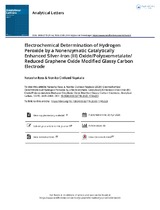Electrochemical determination of hydrogen peroxide by a nonenzymatic catalytically enhanced silver-iron (iii) oxide/polyoxometalate/reduced graphene oxide modified glassy carbon electrode
Abstract
The synergism of phosphomolybdic acid hydrate (POM) decorated with silver-iron (III) oxide (Ag-Fe2O3) nanoparticles and anchored on reduced graphene oxide (RGO) have been demonstrated to be effective as a nonenzymatic H2O2 sensor platform. The assembly of the sensor components and their interactions were probed morphologically, spectroscopically and electrochemically. The Ag-Fe2O3/POM/RGO nanocomposite sensor provided an enhanced electroactive surface area, electrical conductivity and sensitivity for hydrogen peroxide compared to an unmodified glassy carbon electrode (GCE) at –0.55 V versus a saturated calomel electrode. The developed sensor amperometric response was linear across the concentration range from 0.3 mM to 3.3 mM (R2 = 0.992) with a detection limit and sensitivity of 0.2 μM and 271 μA·mM‒1·cm−2 respectively. Concomitantly, a short response time of T90 < 5 sec at a signal-to-noise ratio of 4 was achieved. The sensor was shown to determine hydrogen in the presence of interfering species, and exhibited high selectivity with relative standard deviation values less than 4.2%. The results indicate that the use of RGO to anchor and photochemically reduce POM also improved the reduction properties due to the irregular size distribution and catalytic activity of Ag-Fe2O3 stimulated by its adhesion to the distinctive POM/RGO matrix.

